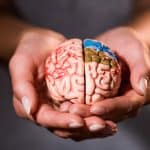Based on the belief that the cranial bones are not fused, American osteopath William Garner Sutherland developed cranial-sacral therapy in the 1930s. Previous to Sutherland’s work, medical practitioners believed that the cranium’s sutures permanently mended the skull bones together, forming an immobile casing for the brain. Careful examination of the skull’s sutures reveals zipper-like lines designed to allow for the subtle movement of the cranial bones.
Sutherland proposed that skull bones move in unison with the rhythmic flow of cerebrospinal fluid surrounding the brain and spinal cord. Cerebrospinal fluid is responsible for nourishing and protecting the central nervous system. Just like energy, blood or lymph circulation, the flow of cerebrospinal fluid can become blocked. Cranial-sacral therapy is primarily comprised of subtle and gentle techniques to release any blockages inhibiting the free flow of cerebrospinal fluid. Adjusting the cranial bones restores mobility to this enclosed system and reduces stress on all of the involved tissues.
Each organ, muscle or tissue within the body is linked to a precise area of the cranial-sacral system through its nerve pathway and associated fascial connections. These nerve and fascial connections facilitate diagnosis and treatment for many dysfunctions. Once a restriction in the central nervous system is identified, cranial-sacral therapy can free it.
Cranial-sacral therapy can be learned easily and incorporated into any bodywork session. While this technique can benefit just about anyone, it is especially helpful for the following conditions:
- Headaches can have a multitude of causes, but are generally accompanied by a circulatory restriction within the cranium. Freeing those restrictions can be a powerful technique to relieve frontal, vertex, temporal, parietal and occipital headaches.
- Head injuries typically occur following some type of blow to the head. The force from the impact can misalign any number of cranial bones, disturbing the cerebrospinal fluid circulation and causing pain. The gentle manipulation of cranial-sacral therapy can relieve pain by realigning skull bones to open previously restricted fluid flow.
- Ear infections typically arise from stagnation of fluids in the middle ear. Due to a lack of drainage through the eustachian tubes, fluid accumulates in the middle ear. Congestion of the eustachian tube may be a result of compression or distortion during the birth process or can be due to an accumulation of mucus. Cranial-sacral treatment can remove obstructions and ensure the drainage of fluids.
- Birth trauma can cause many common childhood conditions such as colic and attention deficit disorder. During the forceful compression of the head twisting through the narrow birth canal, the cranium of a newborn is designed to adapt and flex for its dramatic entrance into the world. However, intense compression of this delicate structure over many hours can push the cranial bones up against each other, distorting the shape of the head. While normal and unavoidable, cranial bones that remain distorted may prevent the proper formation of the skull, affecting development of the brain or impinging on nearby nerves and blood vessels. Cranial-sacral therapy is safe on children and can realign the misaligned cranium.
- Temporal Mandibular Disorder (TMJ) involves tension and misalignment of the mandible and temporal bones. Cranial-sacral therapy’s adjustments to the mastoid, temporal, zygomatic and sphenoid bones can provide TMJ relief.
- Insomnia and Anxiety may not be associated with misalignment of the skull, but cranial-sacral therapy’s invigoration of cerebrospinal fluid can bring someone with anxiety or insomnia significant relief. Since cranial-sacral therapy is inherently relaxing, it has been used to ease anxiety and insomnia.
- Autism has been shown by recent medical research in Canada to be associated with reduced blood supply to the temporal and frontal lobes of the brain. An association has also been made between autism and restricted mobility of the temporal and frontal bones, restricting blood flow to these areas of the brain. It is this association that makes the gentle application of cranial-sacral therapy ideal for treating autism.
- Seizures occur when hyperexcitable nerve cells in the brain fire abnormally. Keeping the cerebrospinal fluid flowing without restriction to bathe the brain keeps nerve cells nourished. This nourishment has the benefit of reducing the susceptibility of seizures.
Widely applicable, cranial-sacral therapy can be an extremely valuable technique to include in a massage therapy session. As recognition of cranial-sacral therapy increases, so will the number of consumers requesting the modality in their sessions.
Recommended Study:















